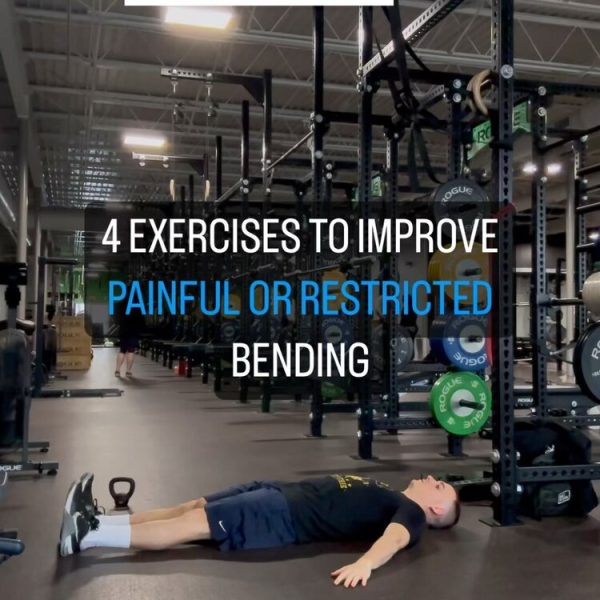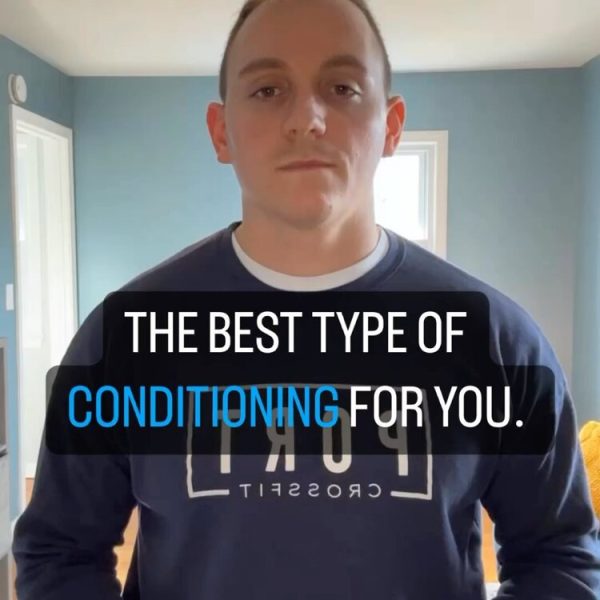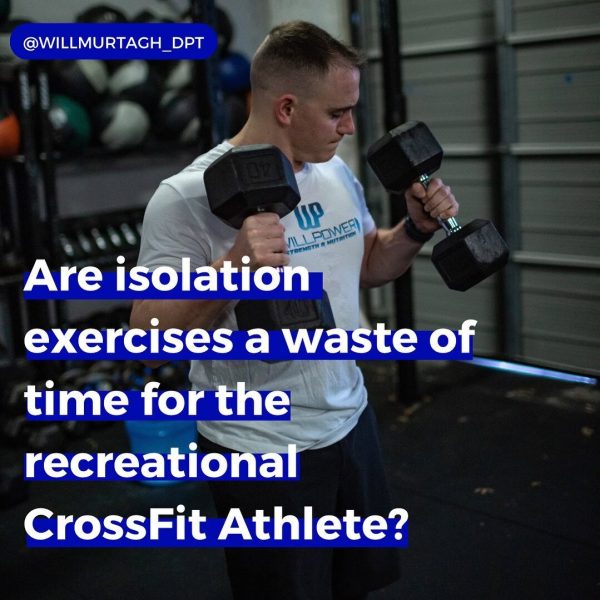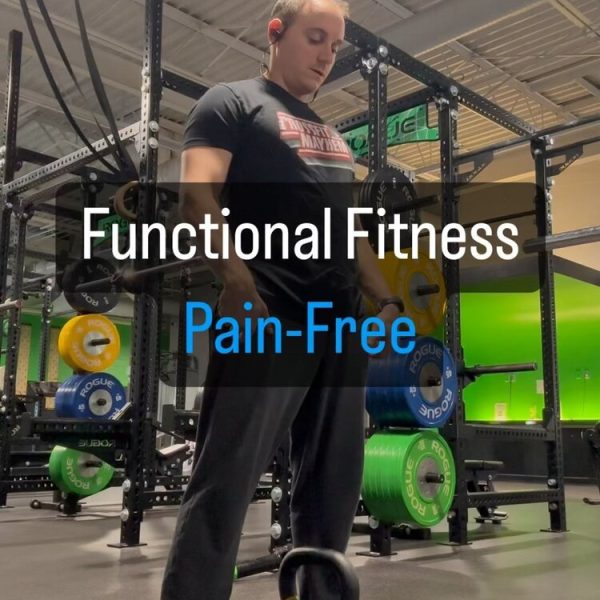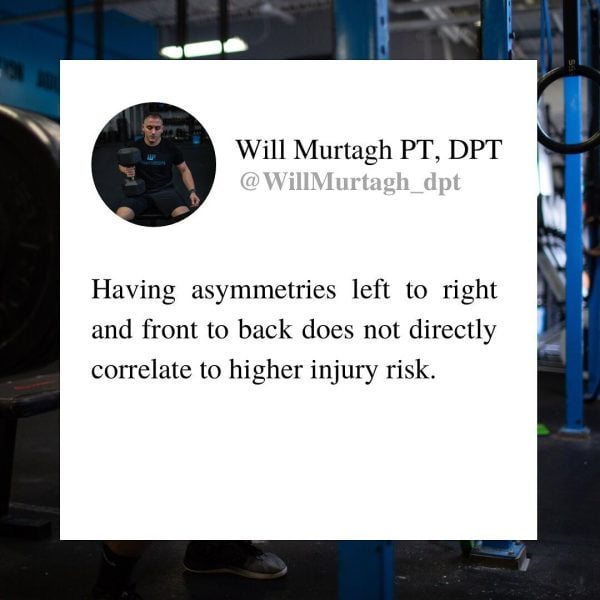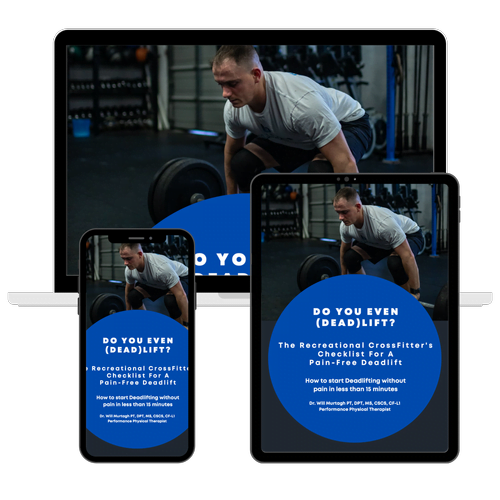Dr. Will Murtagh is a performance physical therapist and writer who helps Fitness Athletes elevate their fitness and train pain-free.
As an affiliate partner of various brands and sponsored content, WillPower Strength & Nutrition may earn commission on qualifying purchases
If you are reading this, then I will assume that you are a CrossFitter who knows they need to start building their strength levels and using heavy weights like many of my 1:1 Pain-Free Performance Program clients.
You may be getting into CrossFit training for the first time and want to get on the fastest route possible to slamming bars and setting PRs. Or, maybe you have been CrossFitting for some time now and realize that if you can’t lift the weight, you can’t play the game.
CrossFit is considered a strength & conditioning program but oftentimes I see that the conditioning piece or the metabolic conditioning is what is prioritized. While the strength piece is placed on the back burner.
The CrossFit training methodology is defined as constantly varied functional movements, executed at high intensity. The term intensity can mean both the paces at which you are moving as well as the loads you are lifting.
It is a training methodology that comprises many different forms of strength and in my opinion, is the best way to develop a variety of different aspects of fitness.
You can be absolutely strong where you can lift high amounts of weight that is loaded onto a barbell or dumbbell. This is what most people will think of when you describe someone as being “strong”. They will most likely go to the big strength lifts or compound exercises such as the Deadlift, Squat, Bench Press, and Strict Press.
Someone can also be relatively strong where they can move their body through space with relative ease. This would encapsulate the gymnastics movements like muscle-ups, handstand push-ups, pistol squats, pull-ups, etc.
They can also have high amounts of speed strength where they can exert large amounts of force in a short amount of time. This would include the Olympic Lifts such as the Clean, Jerk, and Snatch variations.
The speed strength lifts require a degree of absolute strength however they are their classification based on the strength continuum.
The strength continuum is a scale that depicts the different qualities of strength and how it compares to speed ranging from absolute speed such as sprinting to absolute strength.
If your goal is to become the best CrossFitter or compete at the highest level at the CrossFit Games in your gym then building your strength levels up as high as you can should be a priority for you.
But it is important to acknowledge that all three of these variations of strength are needed to excel in CrossFit but this blog post will primarily focus on building Absolute strength or the strength that is concerned with lifting external objects to the highest magnitude such as the big three lifts mentioned above.
Building strength as a CrossFit Athlete can be challenging because although metabolic conditioning or metcons can build great conditioning, they can also take away from high strength levels so managing the high number of inputs to the system is crucial.
Below will be the principles that I use inside of my 1:1 Pain-Free Performance Program to help my clients manage this and optimize their fitness while staying pain-free.
The Importance of Strength In Crossfit
So why should you care about building your absolute strength as a CrossFitter? Why can’t you just focus on the conditioning aspect of “strength & conditioning” and become a beast at Metcons?
Well you can, you could only do Metcons and add in heavyweights from time to time building your strength under fatigue. But this is a game that will have an end date to it.
If you want to build true absolute strength then it cannot be done under fatigue. Expressing the highest amount of strength possible is a function of the anaerobic energy system and thus requires an abundance of high-intensity substrates like Creatine Phosphate and stored ATP (Adenosine Triphosphate).
You can read more about the three energy systems in my blog posts: “3 Signs You Are Not Training Aerobically”
As a quick overview, the three energy systems include:
CP-ATP System
This energy system is primarily used for high-intensity activities ranging from 8-10 seconds and if you train this system consistently you can push it out to 30 seconds.
Glycolytic System
This system is used for higher-intensity activities that are extended beyond the time domain of the CP-ATP system ranging from 30 seconds to 2 minutes. The pace is slower but still above your threshold.
Oxidative System
The third system is designed for work beyond 2 minutes for several hours. The pace varies depending on what interval you are working inside of but the pace can be sustained long term.
The reason why only focusing on metcon’s to develop strength is that during these pieces, although they are intense in their own right and if you are untrained there are strength improvements that occur there are ultimately not enough substrates to lift at the required weights to build significant strength.
Thus, blocking out portions of your workouts or days of the week to focus on building your strength in isolation Is going to be the best way to do so.
How Strength Is Built
Strength is built in a layered approach from the first day that you step into the gym to the day that you win your first CrossFit strength event.
As a beginner, gains in strength will be primarily based on improvements in the ability of your nervous system to recruit the nervous system.
If you have ever experienced or witnessed someone else experiencing “newbie” gains where every day they walk into the gym and they add 10 pounds to their bench press this mechanism is why.
The brain is building more connections to the muscles to improve its ability to coordinate movement.
These rapid gains in strength won’t last forever though. At some point, the adaptations to the nervous system will slow and to continue to build strength you will need to vary the amount of resistance that you use and switch to growing the muscles involved through hypertrophy training.
This can be done through manipulating the repetitions you use in your compound exercises like a Back Squat or through the use of high repetitions isolation exercises as accessory work.
This is because after adaptations to the nervous system are tapped out there will be a direct relationship between muscle size and building strength up to a point. Thus, building muscle mass is a great way to build strength for the sport of CrossFit.
A block style of programming can be useful here where a portion of the year is spent on hypertrophy to build more muscle mass, followed by intensification where you use heavier weights to improve the CNS recruitment of that muscle translating it into strength improvements.
The Best Way to Build Strength For CrossFit Athletes
The best way to design a strength training program for a CrossFit athlete is going to be to take an individualized approach and designed a training session that will work well within a program that contains conditioning in the same training session.
This combination of strength training with conditioning in the same training session is termed “Concurrent Training”.
As mentioned above, there are challenges when trying to build strength in CrossFitters because if not properly designed, the high amounts of conditioning in the methodology can take away from your ability to build strength.
The first step in building strength in a CrossFit Athlete is to ensure that motor control is developed in your training movement pattern so that proper form is used consistently.
The six patterns include squat, hinge, push, pull, lunge, and core.
For movements like the Front Squat, this would look like developing your ability to Air Squat with great technique consistently and longer times under tension.
Once motor control is achieved then you would move into developing strength endurance where the focus switches to varying the resistance that you use to drive improvements in strength.
Strength endurance is what you would typically think of about strength training where sets and reps will progress over time from higher reps and shorter rest periods to lower reps and longer rest periods.
Once significant amounts of time are spent in developing strength endurance, you would then build to fully expressing your built-up strength through the use of maximal contractions.
Maximal contractions are exactly what they sound like. They are the highest amounts of weight you can lift for the lowest number of reps such as 3 and below.
When you have progressed through these three stages you can then look at how your strength training balances with your conditioning.
Concurrent Training Principles
Include your longer and slower conditioning work in muscle mass building hypertrophy phases or times of the year when the focus is on accumulating high volume so the total amounts of work done don’t interfere with your ability to lift at higher percentages.
Your faster conditioning work can be paired with times of the year when you are intensifying your strength training as the fast pieces will typically be lower volume.
Pay attention to which patterns you are using in both your strength training and your conditioning work because even if your strength prescriptions and conditioning paces are perfect if you are squatting in your strength training and squatting in your conditioning there will be fatigue in that pattern and one of the pieces will suffer.
Organize your strength training by the strength continuum and move from high to low nervous system demand activities.
This would look like doing faster speed and lighter exercises before slower and heavier exercises.
For example, do Power Cleans before Front Squats since heavy Front Squats will fatigue you more so than Power Cleans since they require more drive from the nervous system.
Additionally, you will want to have your strength training before your conditioning if your goal is building as much strength as possible.
In the same vein as doing Power Cleans before Front Squats, having your conditioning before your strength training will fatigue your nervous system and deplete the substrates needed to lift as well as possible.
Lastly, if your goal is to build as much strength as possible while also building your conditioning levels as a CrossFit Athlete, you should become familiar with the concept of minimum effective dose.
A minimal effective dose is the lowest amount of work and intensity that illicit a change or an adaptation to your strength training.
The reason that CrossFitters want to flirt with the minimal effective dose for their strength training is that several other things are being developed at the same time as building strength.
Thus, careful consideration needs to be taken to not over-train the system and do just enough work without “spilling over” and performing a total amount of work that cannot be recovered from and adapted to.
Developing your strength is a vital component in becoming the best CrossFitter that you can be. Whether you want to compete at the highest level in the sport or utilize the methodology to its fullest capacity so that you can live your largest life possible outside of the gym.
Getting strong as a CrossFitter comes with challenges but I hope after reading this blog post you now feel equipped to design the training that moves you forward toward your goals.
These are the same principles that I use to design training programs for all of my clients.



